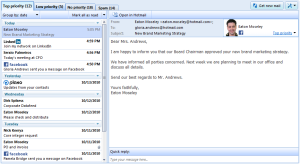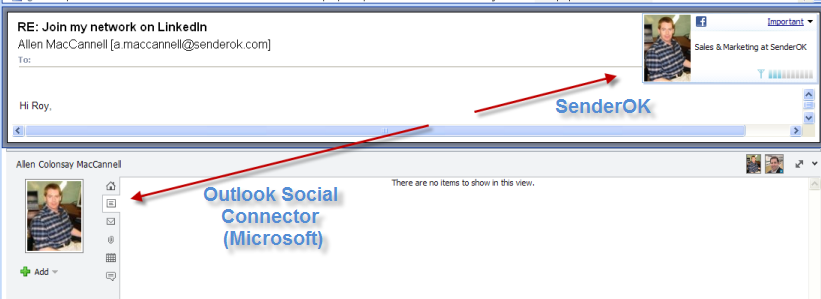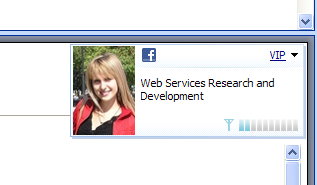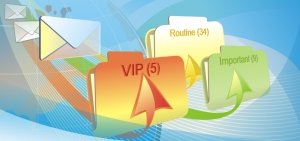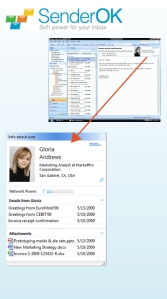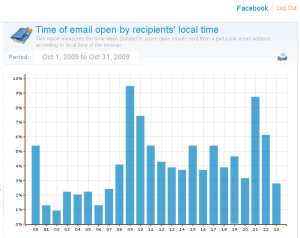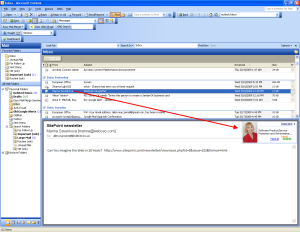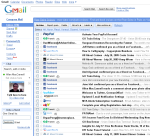While both Google and Facebook can take the following advice on how to satisfy email users who want to reduce email overload, big company theory says that the requisite product manager for at least one of the companies will take off early for Thanksgiving, leaving his/her counterpart to design in the following necessary elements that email users will need to combat information overload going forward. I will present the elements as a mild critique of Facebook’s email announcement last week:
1) Facebook Email Needs a Smart Sorting Algorithm: Most of your priority email will not be trivial comments made by friends on Facebook walls. It will be from business people whom you specifically don’t connect with on Facebook. Nobody in the business world who connects on Facebook only with friends and family (100-200 connections) will see much benefit from having a universal Inbox that sorts mail from only their friends into a “Top Priority” folder.
To that end, EmailTray sorts emails based on a smart algorithm that looks at your past behavior towards senders, other EmailTray users behavior toward senders and whether a sender is in your Outlook address book or you were at a sender’s domain recently. Facebook needs a smart algorithm like this, not knowledge about whether a business email is coming from a family member or close friend (because it won’t be coming from either).
2) Facebook Email Needs a Notifier That Works When Browsers are Closed: EmailTray operates when browsers and Outlook are closed. Only Gmail has a notifier that also does this and we can be sure this Gmail notifier will soon be “smart” in that it will allow users to ask that only “Priority Inbox” mail be sent to the notifier for voice or pop-up alerts. EmailTray already has this and it sorts and alerts you on priority messages from all accounts, not just Gmail accounts.
3) Facebook Email Needs to Ensure Read and Deleted Messages are Marked Read and Deleted at Their Source: When someone reads and/or deletes an email in EmailTray, it will be marked read and/or deleted at its source (in Outlook, Gmail, AOL, Yahoo or Hotmail). This would be critical functionality for Facebook or Google to have in a messaging center. Without this, email users will not bother to process email from all their accounts in Facebook because they would still have to go back to Gmail or Outlook to REDELETE or mark AGAIN as read the same emails they already deleted or marked as read at Facebook. Facebook said nothing about being able to do this yesterday. They (and Google engineers) need to look at this because nobody will want to have to duplicate their efforts in processing email.
4) Facebook Email Needs to Authenticate Email (Anti-Phishing Functionality): Facebook has said nothing about authenticating email as having been actually sent from particular major senders like PayPal or Amazon or LinkedIn. EmailTray does this authentication and sends phishing attempts to the spam box with a warning to the user. This is critical because, for instance, 13% of emails that say they’re from Amazon are not really from Amazon.
Where Facebook has an advantage right now is that email users want to see social network photos with their incoming email. The popularity of xobni, Gist and our EmailTray program (formerly SenderOK) attest to the desire of email users to see who’s sending them messages and learn more about them (sometimes leading to the email user connecting with the email sender on Facebook).
Facebook also has an advantage over Gmail in that the idea of having 3 separate Inboxes is slightly better than the new Gmail Priority Inbox solution that can charitably be described as a 2 Inbox solution.
But, as noted in factor #1 above, neither company has invested in a seriously smart algorithm like the one we use at EmailTray (which has 4 Inboxes).
Click on the above Digg This link if you feel this post deserves to be read more widely. By the way: The instructions for loading Digg buttons on the bottom of WordPress blog posts are severely lacking in competence. Both Digg and WordPress need to get their act together in making it easy to add social media buttons like this.
